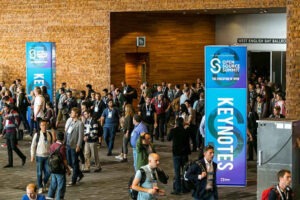Until now the AlmaLinux OS Foundation has been operating with a board of directors that was fully appointed. That’s getting ready to change with an election that’s getting ready to happen.

I’ve been in the dumps lately, mainly from a combination of six years of watching our democracy go down the drain, two-and-a-half years hiding from a virus by mainly staying at home in a rural area where I don’t know anyone who’s anything like me, and a dozen or more years spent watching the open source noncorporate user community become more and more marginalized.
Oh, and then there’s Ukraine.
I was kind of cheered up this afternoon though by some news that crossed my desk. The AlmaLinux OS Foundation is having an election.
If you’re new in town, AlmaLinux OS Foundation is the organization behind AlmaLinux, one of several distros that were formed last year to fill the void left behind when Red Hat pulled the rug from underneath CentOS. This needed to be done, because CentOS had been a downstream drop-in clone of Red Hat Enterprise Linux for most of the 21st century (I’m also bummed that the last phrase means “a meaningful long time,” which bothers me because I spent the majority of my life living in the previous century), and many enterprises used it to run their data centers.
So, why does this cheer me somewhat, given the fact that AlmaLinux is primarily developed for the enterprise, mainly to be used as a server by companies who want RHEL but don’t want to pay for it? The answer is that it offers hope. At least AlmaLinux is keeping its promise to make its software community owned and managed.
It also does a bit to lighten the disappointment I felt the other day when I discovered that the distro had partnered with Oracle (a company on my “strongly dislike” list only because I try not to hate anybody or anything) on a webcast. That didn’t bother me too much (after all, business is business and you do what you gotta do), until I saw that viewing the webcast meant handing your email over to Ellison & Company for marketing purposes.
But that a story for another day.
Today’s announcement is big news (and good news), because it will create AlmaLinux’s first governing body elected from within the distro’s community.
“When we started the AlmaLinux OS Foundation we didn’t have members to vote into a board, and so all current board members were appointed,” AlmaLinux’s chairperson, benny Vasquez (she spells her first name all lower case), said in a blog announcing the election. “Though necessary at the start of any such organization, it is ultimately counter to our goal of ensuring that the folks who are invested in the future of AlmaLinux are the ones to choose the future of AlmaLinux. Our bylaws were setup to include regular elections from the start, to ensure we could achieve the goal of all community members having a voice.”
According to a Wiki established by the distro, the election is to fill seven seats on the foundation’s board of directors. Those running for a seat must be a member the foundation for at least three months by the start of the election (September 4, 2022) and be nominated by an AlmaLinux OS Foundation member in good standing (you cannot nominate yourself). If you’re a member and you want to nominate someone, you can email the name and contact information of the nominee to election2022@almalinux.org.
The election starts on Sept 4, 2022, and will run until at least Sept 19, 2022. Before the election ends, at least 50% of the foundation’s members must vote. Until that happens, the election will remain open.
I just signed up to be a Contributor Member, which is described as “an individual application for anyone who uses AlmaLinux OS, contributes to AlmaLinux OS, provides services to the AlmaLinux OS community or otherwise supports the AlmaLinux OS.” Since I don’t use the distro, contribute code to it, or provide a service, I figure I “otherwise support” the distro by providing “moral support,” which is what a wrote down in the place where they ask. We’ll see if that passes muster. I’m not hopeful.
In the meantime, I need to build a time machine to take me back to a time when I felt that stuff mattered. Does anyone know how? I figure somebody must’ve done that already with an Arduino.
Christine Hall has been a journalist since 1971. In 2001, she began writing a weekly consumer computer column and started covering Linux and FOSS in 2002 after making the switch to GNU/Linux. Follow her on Twitter: @BrideOfLinux




